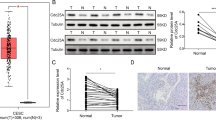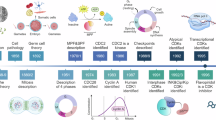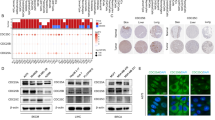Abstract
Cell division cycle 25A (Cdc25A) was shown to colocalise both with nuclear and cytoplasmic proteins. Recently, we have demonstrated that overexpressed Cdc25A promoted the survival of rat 423 cells through indirect activation of PKB-protein kinase B. Using a Cdc25A:ER fusion protein, which can be shuttled from the cytoplasm into the nucleus, the present investigation evidences that the antiapoptotic effect of Cdc25A was restricted to its cytoplasmic localisation in rat 423 cells. In contrast, nuclear Cdc25A overexpression caused dephosphorylation and nuclear retention of the proapoptotic transcription factor Forkhead in rhabdomyosarcoma-like 1 (FKHRL1) in human N.1 ovarian carcinoma cells. This resulted in the increased constitutive expression of the FKHRL1 targets Fas ligand and Bim, and promoted apoptosis. Thus, the Cdc25A oncogene, which was found to be frequently overexpressed in certain human cancers, can increase or decrease the susceptibility to apoptosis depending on the cell-type-specific subcellular distribution.
Similar content being viewed by others
Log in or create a free account to read this content
Gain free access to this article, as well as selected content from this journal and more on nature.com
or
Abbreviations
- Akt:
-
PKB-protein kinase B
- ASK:
-
apoptosis signal-regulating kinase
- ATP:
-
adenosine triphosphate
- Bim:
-
proapoptotic member of the Bcl-2 family of proteins
- Cdc25A:
-
cell division cycle 25A
- Cdk2:
-
cyclin-dependent kinase 2
- DAPI:
-
4′-6-diamino-2-phenylindol
- DTT:
-
DL-dithiothreitol
- EDTA:
-
ethylenediaminetetraacetic acid
- ER:
-
oestrogen receptor
- FasL:
-
Fas ligand
- FCS:
-
foetal calf serum
- FITC:
-
fluorescein isothiocyanate
- GST:
-
glutathione-S-transferase
- FKHRL1:
-
Forkhead in rhabdomyosarcoma-like 1
- HEPES:
-
(N-[2-hydroxyethyl]piperazine-N′-[2-ethanesulphonic acid])
- HO:
-
Hoechst 33258
- 4-OHT:
-
4-hydroxytamoxifen
- IPTG:
-
(isopropyl[beta]-D-thiogalactoside)
- NLS:
-
nuclear localisation signal
- PBS:
-
phosphate-buffered saline
- PI:
-
propidium iodide
- PMSF:
-
phenylmethylsulphonyl fluoride
- PTEN:
-
phosphatase dephosphorylating phosphatidylinositol 3,4,5-trisphosphate (PIP3)
- SDS:
-
sodium dodecyl sulphate
- TNFa:
-
tumour necrosis factor alpha
References
Hernandez S, Hernandez L, Bea S, Pinyol M, Nayach I, Bellosillo B, Nadal A, Ferrer A, Fernandez PL, Montserrat E, Cardesa A and Campo E (2000) cdc25a and the splicing variant cdc25b2, but not cdc25B1, -B3 or -C, are over-expressed in aggressive human non-Hodgkin's lymphomas. Int. J. Cancer 89: 148–152
Gasparotto D, Maestro R, Piccinin S, Vukosavljevic T, Barzan L, Sulfaro S and Boiocchi M (1997) Overexpression of CDC25A and CDC25B in head and neck cancers. Cancer Res. 57: 2366–2368
Cangi MG, Cukor B, Soung P, Signoretti S, Moreira Jr G, Ranashinge M, Cady B, Pagano M and Loda M (2000) Role of the Cdc25A phosphatase in human breast cancer. J. Clin. Invest. 106: 753–761
Galaktionov K, Lee AK, Eckstein J, Draetta G, Meckler J, Loda M and Beach D (1995) CDC25 phosphatases as potential human oncogenes. Science 269: 1575–1577
Nilsson I and Hoffmann I (2000) Cell cycle regulation by the Cdc25 phosphatase family. Prog. Cell Cycle Res. 4: 107–114
Draetta G and Eckstein J (1997) Cdc25 protein phosphatases in cell proliferation. Biochim. Biophys. Acta 1332: M53–M63
Takizawa CG and Morgan DO (2000) Control of mitosis by changes in the subcellular location of cyclin-B1–Cdk1 and Cdc25C. Curr. Opin. Cell Biol. 12: 658–665
Hoffmann I, Draetta G and Karsenti E (1994) Activation of the phosphatase activity of human cdc25A by a cdk2–cyclin E dependent phosphorylation at the G1/S transition. EMBO J. 13: 4302–4310
Sandhu C, Donovan J, Bhattacharya N, Stampfer M, Worland P and Slingerland J (2000) Reduction of Cdc25A contributes to cyclin E1–Cdk2 inhibition at senescence in human mammary epithelial cells. Oncogene 19: 5314–5323
Blomberg I and Hoffmann I (1999) Ectopic expression of Cdc25A accelerates the G(1)/S transition and leads to premature activation of cyclin E- and cyclin A-dependent kinases. Mol. Cell. Biol. 19: 6183–6194
Jinno S, Suto K, Nagata A, Igarashi M, Kanaoka Y, Nojima H and Okayama H (1994) Cdc25A is a novel phosphatase functioning early in the cell cycle. EMBO J. 13: 1549–1556
Sexl V, Diehl JA, Sherr CJ, Ashmun R, Beach D and Roussel MF (1999) A rate limiting function of cdc25A for S phase entry inversely correlates with tyrosine dephosphorylation of Cdk2. Oncogene 18: 573–582
Gu Y, Rosenblatt J and Morgan DO (1992) Cell cycle regulation of CDK2 activity by phosphorylation of Thr160 and Tyr15. EMBO J. 11: 3995–4005
Saha P, Eichbaum Q, Silberman ED, Mayer BJ and Dutta A (1997) p21CIP1 and Cdc25A: competition between an inhibitor and an activator of cyclin-dependent kinases. Mol. Cell. Biol. 17: 4338–4345
Mailand N, Falck J, Lukas C, Syljuasen RG, Welcker M, Bartek J and Lukas J (2000) Rapid destruction of human Cdc25A in response to DNA damage. Science 288: 1425–1429
Conklin DS, Galaktionov K and Beach D (1995) 14-3-3 proteins associate with cdc25 phosphatases. Proc. Natl. Acad. Sci. USA 92: 7892–7896
Galaktionov K, Jessus C and Beach D (1995) Raf1 interaction with Cdc25 phosphatase ties mitogenic signal transduction to cell cycle activation. Genes Dev. 9: 1046–1058
Fuhrmann G, Leisser C, Rosenberger G, Grusch M, Huettenbrenner S, Halama T, Mosberger I, Sasgary S, Cerni C and Krupitza G (2001) Cdc25A phosphatase suppresses apoptosis induced by serum deprivation. Oncogene 20: 4542–4553
Zou X, Tsutsui T, Ray D, Blomquist JF, Ichijo H, Ucker DS and Kiyokawa H (2001) The cell cycle-regulatory CDC25A phosphatase inhibits apoptosis signal-regulating kinase 1. Mol. Cell. Biol. 21: 4818–4828
Rosenberger G (1999) The function of cdc25A in active cell death. Master Thesis, Institute of Clinical Pathology, University of Vienna, Vienna, pp. 1–94
Jackson JG, Kreisberg JI, Koterba AP, Yee D and Brattain MG (2000) Phosphorylation and nuclear exclusion of the forkhead transcription factor FKHR after epidermal growth factor treatment in human breast cancer cells. Oncogene 19: 4574–4581
Brunet A, Park J, Tran H, Hu LS, Hemmings BA and Greenberg ME (2001) Protein kinase SGK mediates survival signals by phosphorylating the forkhead transcription factor FKHRL1 (FOXO3a). Mol. Cell. Biol. 21: 952–965
Brunet A, Bonni A, Zigmond MJ, Lin MZ, Juo P, Hu LS, Anderson MJ, Arden KC, Blenis J and Greenberg ME (1999) Akt promotes cell survival by phosphorylating and inhibiting a Forkhead transcription factor. Cell 96: 857–868
Rena G, Prescott AR, Guo S, Cohen P and Unterman TG (2001) Roles of the forkhead in rhabdomyosarcoma (FKHR) phosphorylation sites in regulating 14-3-3 binding, transactivation and nuclear targeting. Biochem. J. 354: 605–612
Dijkers PF, Medema RH, Pals C, Banerji L, Thomas NS, Lam EW, Burgering BM, Raaijmakers JA, Lammers JW, Koenderman L and Coffer PJ (2000) Forkhead transcription factor FKHR-L1 modulates cytokine-dependent transcriptional regulation of p27(KIP1). Mol. Cell. Biol. 20: 9138–9148
Dijkers PF, Medema RH, Lammers JW, Koenderman L and Coffer PJ (2000) Expression of the pro-apoptotic Bcl-2 family member Bim is regulated by the forkhead transcription factor FKHR-L1. Curr. Biol. 10: 1201–1204
Stahl M, Dijkers PF, Kops GJ, Lens SM, Coffer PJ, Burgering BM and Medema RH (2002) The forkhead transcription factor FoxO regulates transcription of p27Kip1 and Bim in response to IL-2. J. Immunol. 168: 5024–5031
Kops GJ and Burgering BM (1999) Forkhead transcription factors: new insights into protein kinase B (c-akt) signaling. J. Mol. Med. 77: 656–665
Dijkers PF, Birkenkamp KU, Lam EW, Thomas NS, Lammers JW, Koenderman L and Coffer PJ (2002) FKHR-L1 can act as a critical effector of cell death induced by cytokine withdrawal: protein kinase B-enhanced cell survival through maintenance of mitochondrial integrity. J. Cell Biol. 156: 531–542
Grusch M, Rosenberger G, Fuhrmann G, Braun K, Titscher B, Szekeres T, Fritzer-Skekeres M, Oberhuber G, Krohn K, Hengstschlaeger M, Krupitza G and Jayaram HN (1999) Benzamide riboside induces apoptosis independent of Cdc25A expression in human ovarian carcinoma N.1 cells. Cell Death Differ. 6: 736–744
Krupitza G, Grusch M, Braun K, Fuhrmann G, Steinbrugger R, Hulla W, Simonitsch I, Chott A and Hengstschlager M (1998) TNFalpha-mediated cell death is independent of cdc25A. Cell Death Differ. 5: 758–764
Fuhrmann G, Rosenberger G, Grusch M, Klein N, Hofmann J and Krupitza G (1999) The MYC dualism in growth and death. Mutat. Res. 437: 205–217
Galaktionov K, Chen X and Beach D (1996) Cdc25 cell-cycle phosphatase as a target of c-myc. Nature 382: 511–517
Macdonald K and Bennett MR (1999) cdc25A is necessary but not sufficient for optimal c-myc-induced apoptosis and cell proliferation of vascular smooth muscle cells. Circ. Res. 84: 820–830
Wijayaratne AL and McDonnell DP (2001) The human estrogen receptor-alpha is a ubiquitinated protein whose stability is affected differentially by agonists, antagonists, and selective estrogen receptor modulators. J. Biol. Chem. 276: 35684–35692
Brunet A, Kanai F, Stehn J, Xu J, Sarbassova D, Frangioni JV, Dalal SN, DeCaprio JA, Greenberg ME and Yaffe MB (2002) 14-3-3 transits to the nucleus and participates in dynamic nucleocytoplasmic transport. J. Cell Biol. 156: 817–828
Nakae J, Barr V and Accili D (2000) Differential regulation of gene expression by insulin and IGF-1 receptors correlates with phosphorylation of a single amino acid residue in the forkhead transcription factor FKHR. EMBO J. 19: 989–996
Tang ED, Nunez G, Barr FG and Guan KL (1999) Negative regulation of the forkhead transcription factor FKHR by Akt. J. Biol. Chem. 274: 16741–16746
Shin I, Bakin AV, Rodeck U, Brunet A and Arteaga CL (2001) Transforming growth factor beta enhances epithelial cell survival via Akt-dependent regulation of FKHRL1. Mol. Biol. Cell 12: 3328–3339
Nakamura N, Ramaswamy S, Vazquez F, Signoretti S, Loda M and Sellers WR (2000) Forkhead transcription factors are critical effectors of cell death and cell cycle arrest downstream of PTEN. Mol. Cell. Biol. 20: 8969–8982
Littlewood TD, Hancock DC, Danielian PS, Parker MG and Evan GI (1995) A modified oestrogen receptor ligand-binding domain as an improved switch for the regulation of heterologous proteins. Nucleic Acids Res. 23: 1686–1690
Grusch M, Polgar D, Gfatter S, Leuhuber K, Huettenbrenner S, Leisser C, Fuhrmann G, Kassie F, Steinkellner H, Smid K, Peters GJ, Jayaram HN, Klepal W, Szekeres T, Knasmuller S and Krupitza G (2002) Maintenance of ATP favours apoptosis over necrosis triggered by benzamide riboside. Cell Death Differ. 9: 169–178
Grusch M, Fritzer-Szekeres M, Fuhrmann G, Rosenberger G, Luxbacher C, Elford HL, Smid K, Peters GJ, Szekeres T and Krupitza G (2001) Activation of caspases and induction of apoptosis by novel ribonucleotide reductase inhibitors amidox and didox. Exp. Hematol. 29: 623–632
Rosenberger G, Fuhrmann G, Grusch M, Fassl S, Elford HL, Smid K, Peters GJ, Szekeres T and Krupitza G (2000) The ribonucleotide reductase inhibitor trimidox induces c-myc and apoptosis of human ovarian carcinoma cells. Life Sci. 67: 3131–3142
Acknowledgements
We thank the donators providing plasmids and cell lines (listed under ‘Materials and Methods’) and Anton Jaeger for helping with the figures. This work was supported in part by Jubilaeumsfonds der Oesterreichischen Nationalbank, Grant No. 9298, the Herzfelder'sche Familienstiftung and by the Unruhe Privatstiftung (to GK), by the Theodor Koerner Stiftungspreis (to GF) and by a research fellowship of the Medical Faculty of the University of Vienna (to MG).
Author information
Authors and Affiliations
Corresponding author
Additional information
Edited by M. Blagosklonny
Rights and permissions
About this article
Cite this article
Leisser, C., Rosenberger, G., Maier, S. et al. Subcellular localisation of Cdc25A determines cell fate. Cell Death Differ 11, 80–89 (2004). https://doi.org/10.1038/sj.cdd.4401318
Received:
Revised:
Accepted:
Published:
Issue date:
DOI: https://doi.org/10.1038/sj.cdd.4401318



